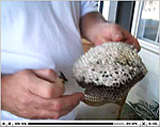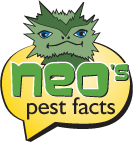The pharaoh ant (Monomorium pharaonis) is a small (2 mm) yellow or light brown, almost transparent ant notorious for being a major indoor nuisance pest, especially in hospitals. The origin of this "tramp" ant is uncertain, although favoured alternatives include West Africa and Indonesia. The Pharaoh ant has been introduced to virtually every area of the world including Europe, the Americas, Australasia and Southeast Asia. Pharaoh ants are a tropical species but they thrive in buildings anywhere, even in temperate regions provided central heating is present.
Unlike most ants the Pharaoh ant is polygynous, meaning its colonies contain many queens (from 2 to over 200). An individual colony normally contains 1000–2500 workers but a high density of nests gives the impression of massive colonies. Colonies also lack nestmate recognition so there is no hostility between neighbouring colonies. Pharaoh ants lack the normal cycle of reproduction observed in most ants; they are able to produce sexual reproductive individuals as required. Laboratory colonies exhibit weak reproductive cycles but this cannot be assumed to be the natural condition. Colonies reproduce by "budding", where a subset of the colony including queens, workers and brood (eggs, larvae and pupae) leave the main colony for an alternative nest site. Budding is the major factor underlying the invasiveness of Pharaoh ants. A single seed colony can populate a large office block, almost to the exclusion of all other insect pests, in less than six months. Elimination and control are made difficult because multiple colonies can also contract into smaller colonies and "weather the storm" of a baiting programme only to rebound when baiting is withdrawn. Pharaoh ants are a major hazard in hospitals, where their small size means they can access wounds, driplines, and instrumentation, causing spread of infection and electrical interference.
Pharaoh ants have become a serious nuisance pest in hospitals, rest homes, apartment dwellings, hotels, grocery stores, food establishments and other buildings. They feed on a wide variety of foods including jellies, honey, shortening, peanut butter, corn syrup, fruit juices, baked goods, soft drinks, greases, dead insects and even shoe polish. Also, these ants gnaw holes in silk, rayon and rubber goods. In hospitals, foraging ants have been found in surgical wounds, I.V. glucose solutions, sealed packs of sterile dressing, soft drinks, water in flower displays and water pitchers. These ants are capable of mechanically transmitting diseases and contaminating sterile materials.








